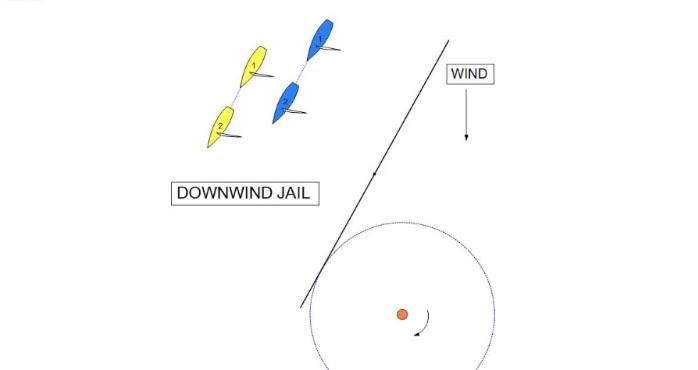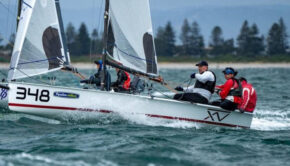Putting your opponent in Downwind Jail
Published on March 1st, 2018
Match racing guru and rules expert Dave Perry brings his two passions together in this report for The Dial Up.
With the deletion of rule 17 (proper course rule), it is much easier to not only find yourself in Downwind Jail, but to put your opponent in Downwind Jail as well. “Downwind Jail” is when one boat is to the right of their opponent (looking downwind) and they can’t gybe and cross, nor can they sail into the zone of the leeward mark/gate or Pin end of the finishing line.
From that position, on the first run it is likely the boat in Downwind Jail will round the leeward mark/gate at least three lengths behind the leader, and in phase with them making it harder to gain on them, and on the second run they will likely lose the race.
The reason the boat is in “jail” is that even if the boats are overlapped and the leeward boat has come from astern, rule 17 is now deleted in match racing (see rule C2.8) meaning there is no rule requiring the leeward boat to not sail above her proper course. Therefore the leeward boat can now sail past the port layline as far as she wants to, or luff towards the windward boat.
In Downwind Jail – Part 1, I explained what you should do if (a) your opponent was in Downwind Jail, and (b) you were in Downwind Jail. To read that article, click here. In Downwind Jail – Part 2, I explained how to put your opponent in Downwind Jail when you are trailing around the windward mark.
In this report, I will describe how to put your opponent in Downwind Jail when you are leading around the windward mark:
• If the trailer gybes to starboard tack *before* you have reached the “first layline”:
The key to knowing what to do is knowing where the “first layline” is. The “first layline” means, on the first run, the starboard-tack layline to the leeward mark; or if a gate, to the right-hand gate mark (looking downwind). On the second run, the “first layline” is the starboard-tack layline to the Pin end of the finishing line (right-hand end looking downwind).
If you are not at the “first layline” yet and the trailing boat gybes, do not gybe (which is what most inexperienced match racers do)! You are “Happy to Let Them Go!” You sail 2-3 lengths and then gybe with your wind clearly behind them. Your opponent is now in Downwind Jail.
At first they may be able to gybe and go behind you…never let them go behind you (called “crossing over”). You may be able to close gauge with them and make it harder for them to gybe; and if they gybe, you may be able to “hunt” them (head up and prevent them from getting behind you, and forcing them to gybe back to starboard).
But if you can’t prevent them from going behind you, you have to gybe *before* they get to you, and stay to their left (looking downwind). Eventually you will arrive at the “first layline” (see what to do later in this article).
But if they get at all advanced on you (either because they are sailing faster, or because you are sailing higher and closing the distance with them), they will get to the point where they can NOT gybe at all, or cannot gybe and get behind you. And if they cannot sail into the zone of the leeward mark/right-hand gate mark or Pin on starboard-tack…you own them!
• If the trailer has not gybed and you are nearing the “first layline”:
Your first strategy is to try to sail a little lower than your opponent and move your opponent to windward of your centerline, without any risk of them overlapping you, which would be a problem given that there is no rule 17 in match racing so they can luff you aggressively. Then gybe a couple of lengths before the “first layline.” If your opponent crosses over, you have clear air and as long as you can sail into the zone on starboard tack, you beat them to the mark.
But if your opponent gybes simultaneously with you (“simo gybes”), then you need to Gybe Hot (meaning come out of your gybe on a high angle). This may be enough to keep your wind in front of theirs. But even if they eventually roll you, you will have pushed the game well above the layline to the mark, and now your opponent is in Downwind Jail.
Even better, set up for a “fake gybe” and see if you can get your opponent to gybe first *before* you get to the “first layline.” Then you go another 2-3 lengths and gybe with your wind safely behind them. A “fake gybe” (or what I call Flicking Them Off) works best when the trailer is within one (1) length of you.
The reason it works is that the skipper of the trailing boat plans to do a “simo gybe” and knows you are nearing the layline where you will gybe, and is in a heightened state of anticipation. Try the “fake gybe” when you are about 8-10 lengths from the layline. You need to time to reaccelerate after the “fake gybe” and still get your real gybe in just before getting to the “first layline.”
To execute the “fake gybe” in a way that slows your boat the least, initiate the fake with a casual “stand by gybe” or some words that might put your opponent on high alert. Have your bow person begin to go through their maneuver to gybe the pole, but even if they take the pole off the mast, be sure they leave the inboard end of the pole near the mast!
What will send the trailer is seeing you bear away and begin to pull on the mainsheet as if you are gybing the boom. Watch them out of the corner of your eye (don’t stare at them…it is a dead give-away) and when they “bite” (gybe), you simply head up, build speed, sail 2-3 lengths and gybe with your wind behind the trailer. The trailer is now in Downwind Jail.
If the trailer does not bite, simply head up and build speed. The trailer may even be more to windward of your centerline now. Gybe just before the “first layline” and be ready to Gybe Hot if the trailer simo gybes with you.












 We’ll keep your information safe.
We’ll keep your information safe.